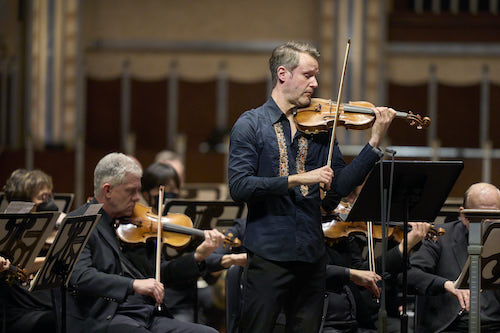by Peter Feher

William Walton’s Violin Concerto might belong first and foremost to its original star, Jascha Heifetz, but Cleveland can also claim it. The Orchestra accompanied the famed violinist for the world premiere in December 1939, and if those are big shoes to fill in 2022, Otto and his fellow musicians were more than up for the task.
The virtuosity of the performance on Thursday, March 10 had all to do with its flexibility. Otto went from furious bowing action to the most delicate of high notes in the concerto’s opening, marked “Andante tranquillo” but prone to mood swings beyond that. Abrupt shifts structure the entire piece. The second movement alternates between two dance forms (a tarantella and a waltz), and the finale’s cadenza traverses the whole range of the violin several times over.
What united these extremes was a high level of precision that you could not only hear but see. Concertgoers who don’t play a string instrument could still grasp the clean technique on display, from busy pizzicato notes to shifts up and down the length of the fingerboard. Lyricism was another effect that Otto and orchestra showcased with control and ease — the essential ingredients for any virtuoso performance.
The ensemble pushed its playing to the limit with the concert’s opener, Thomas Adès’ The Exterminating Angel. Drawn from the composer’s opera of the same name, the four-movement work, here receiving its U.S. premiere, asks the orchestra to get ear-splitting-loud. The brutal “March” also makes for a blatant warning in a piece full of unsettling moments.
Adès (above), who was in attendance, couldn’t have found a better combination of conductor and orchestra outside of Vienna for the symphony’s final movement, “Waltzes.” Welser-Möst and The Cleveland Orchestra brought off each gesture with Johann-Strauss style, even as the dance loses its charm and the music grows more demented.
The loud moments during the program’s second half, occupied by Sibelius’ Symphony No. 5, were grand rather than threatening. The Presto section that overtakes the first movement, gradually building in tempo and volume over twelve minutes, came off as magnificent in its rush to the end.
Welser-Möst got affectionate with a melody in the first violins, inviting uncharacteristic but necessary lightness into the middle, intermezzo movement — a break from the wall of sound. Just as effective were the pauses between the work’s definitive, closing chords, which stayed rhythmic and drove the music to a convincing conclusion.
If there was an additional urgency to Thursday’s performance, president and CEO André Gremillet spelled it out in a program note, mentioning that war was the backdrop to much 20th-century music, and dedicating the week’s concerts to Cleveland’s Ukrainian community. The gesture fit well for a program that was already about not taking anything for granted.
Photos by Roger Mastroianni
Published on ClevelandClassical.com March 16, 2022.
Click here for a printable copy of this article




